West Adams Neighbors Come Together to Oppose the Drillers Next Door
3:16 PM PST on January 14, 2014
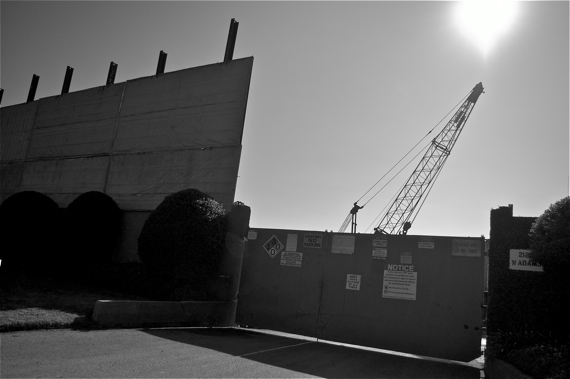
"So, those are not water trucks we see coming through the neighborhood?" asked an older gentleman enjoying the sunny Saturday afternoon with friends outside one of the men's homes in the West Adams neighborhood.
He was referring to the numerous heavy trucks ferrying enormous containers of acids and other drilling-related equipment and materials to the oil and gas drilling sites run by Freeport-McMoRan Oil & Gas (FM O&G) in the area.
"Hardly," I said, telling them about some of the issues raised at the emergency community meeting earlier that day regarding FM O&G's activities at the Murphy Drill Site (located at 2126 W. Adams) and their plans to begin drilling and redrilling several wells at the Jefferson/Budlong site at the end of the month.
The 300+ residents that had attended the meeting, I explained, were deeply concerned about loud noises and alarming odors coming from the Murphy site since the latest round of drilling began in late November of last year.
And, it wasn't the first time they'd been unhappy with their neighbor.
Back in 2004, similar complaints were lodged with the fire department and the city when redrilling began at two of the 27 wells on the 3-acre Murphy site. But now, newer techniques for well-stimulation that entail pumping thousands of gallons of acid into the spiderweb of pipelines that run horizontally underneath much of the neighborhood have stirred even more fears. Citing the more than 50 underground pipelines emanating from the wellhead at the Jefferson/Budlong site alone, neighbors worry that the community could be devastated if something were to go wrong.
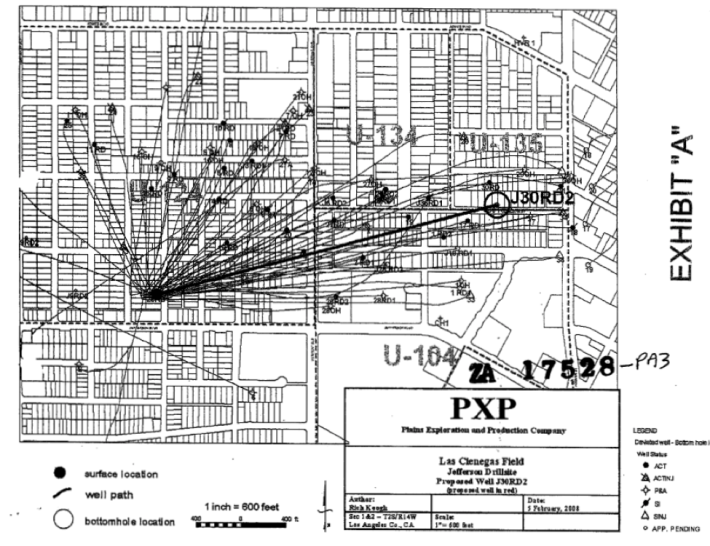
The gentlemen took that in for a moment.
"They're drilling for oil? Right here?" asked one, demanding to see my camera and the photos that I had taken outside the Murphy site.
"Oh yeah..." mused another, after seeing the photo of the rig (at top), noting that he had heard some people in the area made a little money off drilling under their property.
But most of them hadn't known that, until last week, drilling had been underway just a handful of blocks from where they were standing. They weren't particularly happy to hear about it, either, and wondered why they hadn't been informed.
There are a few reasons for that.
For one, the walls around the sites are pretty high and are adorned with a substantial amount of landscaping to help the sites blend in with the neighborhood. And, the new sections of wall appearing along Adams (visible above), although apparently installed as sound barriers, serve the function of hiding tall drilling rigs.
That is by design -- the city requires that facilities be as concealed as possible so as to be "reasonably protected against public entry, observation or attraction" (see p. 586). And, extraction facilities are not particularly beautiful and can appear somewhat ominous when bustling with activity and drilling is underway.
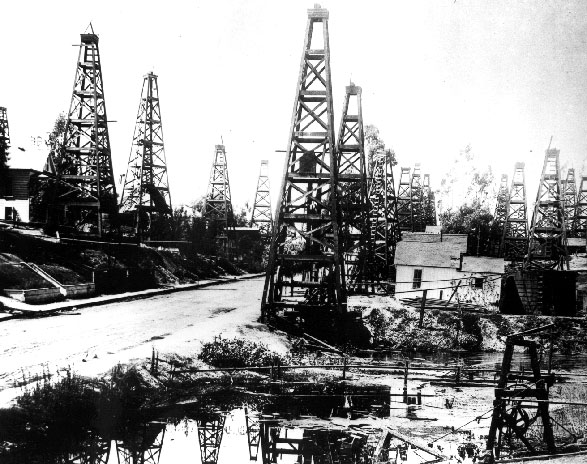
But, the concealment also makes it harder for neighbors to discern (and, therefore, monitor) what is happening behind the nicely landscaped walls.
Unless you had a view overlooking a site, as the home next to the Jefferson/Budlong site does (below), it might never occur to you that oil was being drilled just feet from where you were standing.
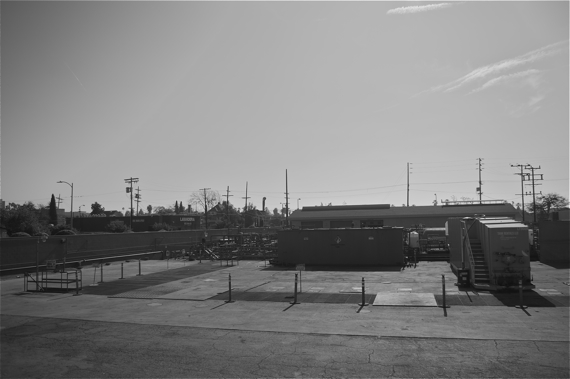
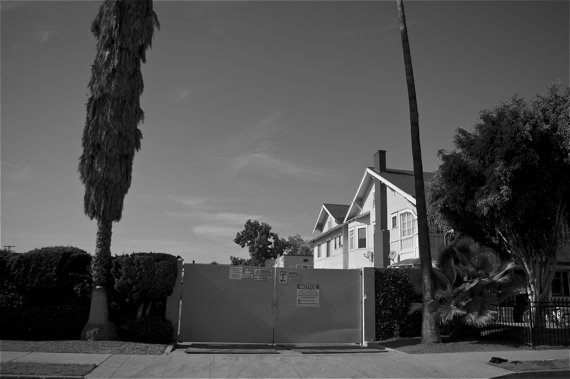
Which leads to the second reason why neighbors were unaware of FM O&G's operations: namely, FM O&G hasn't been particularly eager to introduce themselves to the community.
Representatives from FM O&G did have to appear before the Zoning Administration back in September, after neighbors complained about both their bad behavior in the area (illegally painting curbs red, "misting" cars and homes in the area with oil, parking on and crushing sidewalks, constant loud noises, etc.) and the lack of public notice regarding drilling activities.
The knuckle-rapping they received from Zoning Administration didn't seem to have much of an effect, however.
According to members of the Redeemer Community Partnership, one of several churches that have been active on the issue in the area, FM O&G's most recent application for permits to drill at the Jefferson site was replete with requests that public hearings on the matter be waived. (*for text of one such letter, see below)
When neighbors did hear from FM O&G in October, it was in the form of flyers asking them to oppose a proposal by City Councilmembers Paul Koretz and Mike Bonin that would ban extreme methods of extraction within the city.
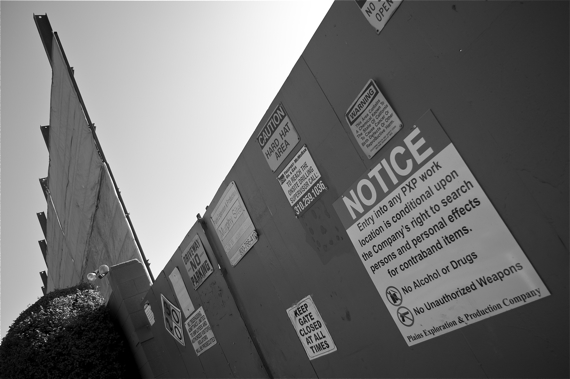
For those whose residences or properties do not fall within a 1500-foot radius of the wellhead or
within 500 feet of the path of the well and are therefore not required to be notified of drilling activities, information about who runs the site and what is going on there is hard to come by.
Even signage on both the Jefferson/Budlong and Murphy sites is somewhat confusing, with the largest signs still referring to Plains Exploration & Petroleum (PXP), the corporation bought by FM O&G last spring.
For those lucky residents who are given the required 30 days' advance notice regarding plans to drill, their ability to do anything about it or learn more about the chemicals being trucked into the community and pumped under their homes is limited. Thanks to Senate Bill 4 (SB-4), corporations are now required to publicly disclose some basic information about the chemicals used in their extraction operations, but they don't have to do so until drilling has been completed, months later.
And, while some might take heart that a new rule adopted by the Air Quality Management District (AQMD) last year requires that the agency be given 24-hour notice prior to the commencement of drilling, well completion, or other such activities at a site, unless agents are at the facility doing the monitoring themselves, there is no guarantee that the operations are being conducted safely.
Resident and co-founder of CoWatching Oil LA, DonnaAnn Ward, for example, recently reported a suspicious odor to the AQMD only to find that the odor was the least of her worries. The agent that came out to investigate the complaint discovered that, due to a leak, he was getting a natural gas emissions reading that was 40 times higher than the allowable limits.
What disconcerted Ward was that, "...No one knew [the leak] was happening...If I hadn't called, it simply would have gone on."
And, the fact that FM O&G is not working with the fire department and other important players in the community to either keep them informed of operations or help create contingency or evacuation plans in case of an emergency makes her and other concerned residents very uneasy.
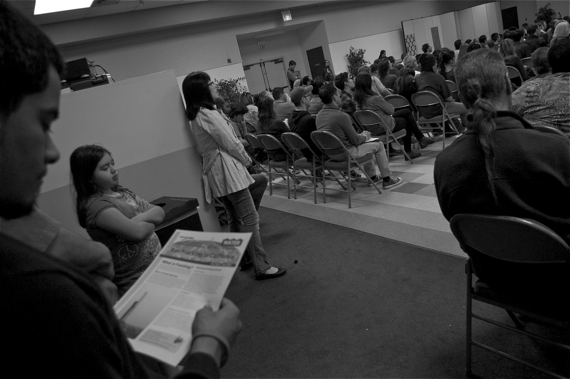
The gentlemen I had been speaking with looked troubled.
They wanted to know what could be done to halt the extraction operations.
It's a tough case, I told them.
While both Freeport and AllenCo -- whose site north of USC may be permanently shuttered -- lease land from the Archdiocese and pay the Church hefty royalties, that's where the similarities end.
AllenCo had racked up a long list of violations over several years' time, including as many as 250 health complaints. Not only was the case clear-cut, AllenCo is a local and comparatively small corporation in the world of oil and gas giants.
Freeport-McMoRan is a multi-billion dollar (and somewhat infamous) transnational corporation that has been in the extraction business of one form or another for over 100 years. And, until Ward placed her call to the AQMD earlier this month, they had been violation-free at both sites (see AQMD records here and here).
Right now, all they are technically guilty of is being a somewhat unneighborly neighbor.
The men shook their heads, not sure what else to ask. One finally pointed at my bike and asked if I preferred to do my crime-fighting on two wheels.
"Oil corporations are responding to demand," I shrugged. "If you want to decrease the demand for oil, then you have to use less of it, right?"
He burst out laughing and clapped me on the shoulder.
"That's good thinking," he said, half laughing at me and half laughing with me.
He is not the first to have found that line of thinking amusing.
"Well," I smiled, taking my leave. "You gotta start somewhere."
* * * *
*An excerpt of Freeport's July 5, 2013 request to the Zoning Administration that a public hearing regarding drilling at the Jefferson site be waived:
Freeport-McMoRan Oil & Gas LLC respectfully requests approval to use the above referenced controlled drill site to drill and re-drill three (3) wells as more particularly describe in the materials submitted herewith...Applicant wishes to draw your attention to the last Associate Zoning Administrator's Finding of Fact, that "the current conditions of operations at this location are effective in reasonably mitigating any possible impact of the use of the site for drilling operations." (ZA Case No. ZA-17528(PA3), dated April 22, 2008...Because of this Finding, a public hearing was waived in 2008.
Accordingly, as was done in 2008, Applicant respectfully requests that the public hearing in this matter be waived. If a public hearing is set, Applicant's representative requests that the matter not be set for hearing on the following dates: August 14, 2013 through August 25, 2013.
Sahra is Communities Editor for Streetsblog L.A., covering the intersection of mobility with race, class, history, representation, policing, housing, health, culture, community, and access to the public space in Boyle Heights and South Central Los Angeles.
Stay in touch
Sign up for our free newsletter
More from Streetsblog Los Angeles
Metro Board Funds Free Student Transit Pass Program through July 2025
Metro student free passes funded another year - plus other updates from today's Metro board meeting
Eyes on the Street: New Lincoln Park Avenue Bike Lanes
The recently installed 1.25-mile long bikeway spans Lincoln Park Avenue, Flora Avenue, and Sierra Street - it's arguably the first new bike facility of the Measure HLA era
Brightline West Breaks Ground on Vegas to SoCal High-Speed Rail
Brightline West will be a 218-mile 186-mile-per-hour rail line from Vegas to Rancho Cucamonga - about 40 miles east of downtown L.A. - expected to open in 2028




